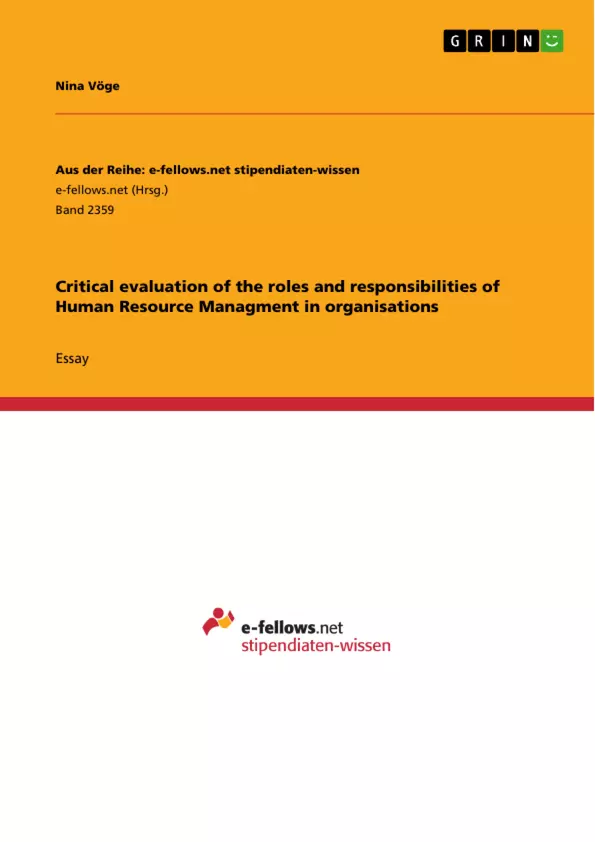As an organisation constantly interacts with and relies on its environment, change can be seen as one of the main threads running through the evolution of Human Resource Management (HRM). Indeed, as research confirms, external trends such as new technological developments, ongoing globalisation, changing demographics and increased attention towards wellbeing are important predictors of how work is managed today.
Considering the evolution of HRM overtime, it is apparent that both its roles and responsibilities in organisations have changed significantly. Within the context of organisational change this essay aims to critically evaluate HRM’s roles and responsibilities.
Early theories suggest that HRM is as a necessity to reassess how to manage people and their welfare at work. During the industrial age the Principles of Scientific Management by Frederick Taylor proposed that efficiency and productivity could be achieved best of all through rationalised modes of production. It was during that time, that the importance of HR and people management as a profession grew considerably. By the middle of the 20th-century academic research in the fields of psychology, anthropology and sociology began to emphasise the behavioural and emotional context of the employment relationship, leading to an understanding of HRM as a more holistic perspective.
Inhaltsverzeichnis (Table of Contents)
- Human Resource Management in context
- Handling change within different models of HRM roles
- Highlighting HRM's roles in the context of organisational change
- HRM in its role as a strategist and leader
Zielsetzung und Themenschwerpunkte (Objectives and Key Themes)
This essay critically evaluates the evolving roles and responsibilities of Human Resource Management (HRM) in organisations, taking into account the impact of external change factors. It delves into the historical evolution of HRM and discusses the shift from traditional personnel management to a more strategic approach.
- The impact of change on HRM roles and responsibilities
- Different models of HRM roles and their implications for organisational change
- The strategic importance of HRM in relation to business performance
- The role of HRM in fostering employee well-being and organisational effectiveness
- The influence of line manager competency on the effectiveness of HRM practices
Zusammenfassung der Kapitel (Chapter Summaries)
- Human Resource Management in context: This chapter explores the historical evolution of HRM, highlighting the influence of external trends such as technological advancements, globalisation, and changing demographics. It discusses the shift from traditional personnel management to a more strategic approach, emphasizing the importance of achieving competitive advantage through a committed and capable workforce.
- Handling change within different models of HRM roles: This section examines different models of HRM roles that have emerged in response to organisational change. It explores the evolution of these models, starting with Legge's HR innovator model and progressing to more contemporary frameworks like Story's strategic/tactical model and Caldwell's Champion, Adapter, Consultant and Synergist model. The chapter examines the different roles and responsibilities associated with each model, highlighting the increasing importance of change management within HRM.
- Highlighting HRM's roles in the context of organisational change: This chapter further analyzes the roles of HRM in managing organisational change, focusing on Caldwell's model and Ulrich's updated model. It examines how different models emphasize the importance of change agents, strategic partners, and human capital developers within the HRM function.
- HRM in its role as a strategist and leader: This chapter examines the role of HRM as a strategic leader within organisations. It delves into Ulrich and Brockbank's updated model, which highlights the importance of HRM in supporting business development, managing change processes, and providing leadership within the organization. It also emphasizes the role of HRM in balancing various responsibilities and fostering a holistic leadership approach.
Schlüsselwörter (Keywords)
Key terms and concepts explored in this text include Human Resource Management (HRM), Strategic Human Resource Management (SHRM), Organisational Change, Employee Well-being, Competitive Advantage, Leadership, Role Pluralism, and Line Manager Competency. The text analyzes various models of HRM roles, including the HR Innovator Model, Strategic/Tactical Model, Champion, Adapter, Consultant and Synergist Model, and Ulrich's Updated Model.
- Quote paper
- Nina Vöge (Author), 2016, Critical evaluation of the roles and responsibilities of Human Resource Managment in organisations, Munich, GRIN Verlag, https://www.grin.com/document/368478



